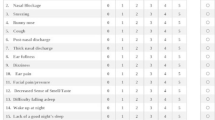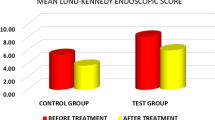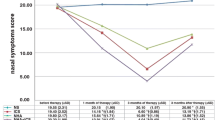Abstract
Chronic rhinosinusitis is a common disease which causes persisting inflammatory conditions of one or more sinuses. This study was designed to evaluate the effect of thyme honey nasal spray as an adjunctive medication on chronic rhinosinusitis after functional endoscopic sinus surgery. This was a randomized, placebo controlled, double-blind clinical study. 64 patients with chronic rhinosinusitis undergoing functional endoscopic sinus surgery were enrolled in this study. Patients were randomized and blinded to receive either placebo or thyme honey nasal spray in addition to the standard regimen postoperatively. Patients were visited on postoperative days 7, 30 and 60. The sino-nasal outcome test, endoscopic grading system and sinus CT-scan were scored before operation and on the day 60 after surgery. 54 patients completed the study. Significant improvement was observed in both treatment groups. There were no significant changes in SNOT-22, endoscopy and CT-scan scores between the two study groups. However, a greater reduction in endoscopic scores was shown in thyme honey group. The incidence of adverse effects was not significantly different between the groups, but synechiae formation and epistaxis were lower in treatment group. Thyme honey nasal spray seems to be a low-priced potential adjuvant remedy with excellent safety profile, to reduce inflammation and polyp formation and also fostering mucosal healing for patients suffering from chronic rhinosinusitis. However, further studies are recommended.


Similar content being viewed by others
References
Pant H, Schembri MA, Wormald PJ et al (2009) IgE-mediated fungal allergy in allergic fungal sinusitis. Laryngoscope 119:1046–1052. doi:10.1002/lary.20170
Lusby PE, Coombes AL, Wilkinson JM (2005) Bactericidal activity of different honeys against pathogenic bacteria. Arch Med Res 36:464–467
Thamboo A, Thamboo A, Philpott C, Javer A, Clark A (2011) Single-blind study of manuka honey in allergic fungal rhinosinusitis. J Otolaryngol Head Neck Surg 40(3):238–243
Hotta M, Nakata R, Katsukawa M, Hori K, Takahashi S, Inoue H (2010) Carvacrol, a component of thyme oil, activates PPAR α and γ and suppresses COX-2 expression. J Lipid Res 51:132–139. doi:10.1194/jlr.M900255-JLR200
Vinas P, Soler-Romera MJ, Hernandez-Cordoba M (2006) Liquid chromatographic determination of phenol, thymol and carvacrol in honey using fluorimetric detection. Talanta 15(69):1063–1067. doi:10.1016/j.talanta.2005.12.030
Manisha DM, Shyamapada M (2011) Honey: its medicinal property and antibacterial activity. Asian Pac J Trop Biomed 1:154–160. doi:10.1016/S2221-1691(11)60016-6
Tan HT, Abdul Rahman R, Gan SH et al (2009) The antibacterial properties of Malaysian tualang honey against wound and enteric microorganisms in comparison to manuka honey. BMC Complement Altern Med 9:34. doi:10.1186/1472-6882-9-34
Kilty SJ, Mutari D, Melanie Duval M, Groleau MA, Nanassy J, Gomes MM (2010) Manuka honey: histological effect on respiratory mucosa. Am J Rhinol Allergy 24:63–66. doi:10.2500/ajra.2010.24.3453
Lusby PE, Coombes A, Wilkinson JM (2002) Honey: a potent agent for wound healing? J Wound Ostomy Continence Nurs 29:295–300
Haniyeh K, Seyyed MS, Hussein M (2010) Preliminary study on the antibacterial activity of some medicinal plants of Khuzestan (Iran). Asian Pac J Trop Med 3(3):180–184. doi:10.1016/S1995-7645(10)60004-1
Alendejani T, Marsan JG, Ferris W, Slinger R, Chan F (2008) Effectiveness of honey on S.aureus and P.aeruginosa biofilms. Otolaryngol Head Neck Surg 139:107–111. doi:10.1016/j.otohns.2009.01.005
Allen KL, Hutchinson G, Molan PC (2000) The potential for using honey to treat wounds infected with MRSA and VRE. First World Healing Congress, Melbourne, pp 10–13
Kingsley A (2001) The use of honey in the treatment of infected wound: case studies. Br J Nurs 10:13–16
Visavadia BG, Honeysett J, Danford MH (2008) Manuka honey dressing: an effective treatment for chronic wound infections. Br J Oral Maxillofac Surg 46(1):55–56
Zekovic ZP, Lepojevic ZD, Markov SL, Milosevic SG (2002) Tablets with thyme (Thymus vulgaris L.) extracts. APTEFF 33:159–165
Tohidpour A, Sattari M, Omidbaigi R, Yadegar A, Nazemi J (2010) Antibacterial effect of essential oils from two medicinal plants against Methicillin-resistant staphylococcus aureus (MRSA). Phytomedicine 17:142–145. doi:10.1016/j.phymed.2009.05.007
Tsigouri A, Passaloglou-Katrali M, Sabatakou O (2008) Determination of eucalyptol camphor menthol and thymol in Greek thyme honey by GC-FID. Acta Alimentaria 37(2):181–189. doi:10.1556/AAlim.2007.0032
Chang EH, Alandejani T, Akbari E, Ostry A, Javer A (2011) Double-blinded, randomized, controlled trial of medicated versus non-medicated merocel sponges for functional endoscopic sinus surgery. J Otolaryngol Head Neck Surg 40:S14–S19
Falcone P, Speranza B, Del Nobile MA, Corbo MR, Sinigaglia M (2005) A study on the antimicrobial activity of thymol intended as a natural preservative. J Food Prot 68(8):1664–1670
Nostro A, Roccaro AS, Bisignano G et al (2007) Effects of oregano, carvacrol and thymol on Staphylococcus aureus and Staphylococcus epidermidis biofilms. J Med Microbiol 56:519–523. doi:10.1099/jmm.0.46804-0
Gavliakova S, Biringerova Z, Buday T et al (2013) Antitussive effects of nasal thymol challenges in healthy volunteers. Respir Physiol Neurobiol 187(1):104–107. doi:10.1016/j.resp.2013.02.011
Meltzer Eli O, Hamilos Daniel L (2011) Rhinosinusitis diagnosis and management for the clinician: a synopsis of recent consensus guidelines. Mayo Clin Proc 86(5):427–443. doi:10.4065/mcp.2010.0392
Acknowledgments
We would like to thank Dr. Mohammad Seifrabiei (statistical analyst), Mrs. Ghodsieh Saki (microbiologist) and Mrs. Faranak Noorbakhsh (radiology technician) for their kind cooperation in this study. This study is funded by an academic research grant provided by Hamadan University of Medical Sciences.
Conflict of interest
There is no conflict of interest in this study.
Author information
Authors and Affiliations
Corresponding author
Rights and permissions
About this article
Cite this article
Hashemian, F., Baghbanian, N., Majd, Z. et al. The effect of thyme honey nasal spray on chronic rhinosinusitis: a double-blind randomized controlled clinical trial. Eur Arch Otorhinolaryngol 272, 1429–1435 (2015). https://doi.org/10.1007/s00405-014-3233-x
Received:
Accepted:
Published:
Issue Date:
DOI: https://doi.org/10.1007/s00405-014-3233-x




